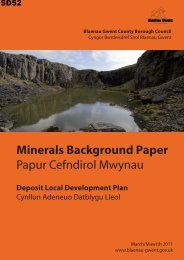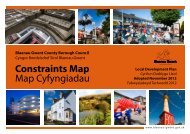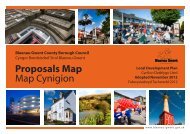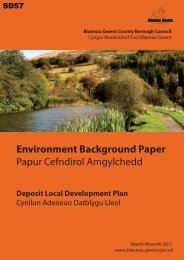Planning Policy Wales - Brecon Beacons National Park
Planning Policy Wales - Brecon Beacons National Park
Planning Policy Wales - Brecon Beacons National Park
You also want an ePaper? Increase the reach of your titles
YUMPU automatically turns print PDFs into web optimized ePapers that Google loves.
7.6.2 Where applications are considered for business development in primarily<br />
residential areas particular care should be taken to safeguard residential amenity, especially<br />
where there is potential for noise and/or traffic disturbance. <strong>Planning</strong> conditions may be used to<br />
control, for example, times of operation in order to protect amenity.<br />
7.6.3 Occupancy conditions, defining the categories of people or firms who may occupy<br />
the premises, should be imposed only when this can be justified on planning grounds and where<br />
the alternative would normally be to refuse permission. In most cases it would not be appropriate<br />
to impose such conditions on buildings of less than 300 square metres of office floorspace or<br />
500 square metres of industrial floorspace. Occupancy conditions may not be imposed which<br />
provide for a system of vetting by the local planning authority or the use of a vague test such as<br />
needing to be located in the area.<br />
7.6.4 Unless intensification amounts to a material change in the character of use, it cannot<br />
be controlled if unconditional planning permission has been granted. <strong>Planning</strong> authorities should<br />
therefore consider the use of planning conditions or planning obligations on the initial permission to<br />
safeguard local amenity.<br />
7.6.5 A flexible attitude is required with respect to change of use to enable suitable re-use or<br />
new use to be instituted in under-used space where this might contribute to the preservation of the<br />
building or enhancement of the townscape or landscape.<br />
7.6.6 Local planning authorities should adopt a constructive approach towards agricultural<br />
development proposals, especially those which are designed to meet the needs of changing<br />
farming practices, or are necessary to achieve compliance with new environmental, hygiene or<br />
welfare legislation 13 .<br />
7.6.7 Agriculture and forestry permitted development rights 14 are granted to meet<br />
farming and forestry needs and not for purposes of diversification. They should not be abused,<br />
for example, to circumvent normal planning policies on new building in the open countryside. Local<br />
planning authorities should check the lawfulness of developments to be carried out under permitted<br />
development rights. New farm buildings must be sited on land which is in use for agriculture for the<br />
purposes of a trade or business, and must be reasonably necessary for the purposes of agriculture.<br />
They must be within an agricultural unit which is at least 5 hectares in area, as well as meeting other<br />
conditions governing the exercise of permitted development rights.<br />
7.6.8 The re-use and adaptation of existing rural buildings has an important role in<br />
meeting the needs of rural areas for commercial and industrial development, as well as for tourism,<br />
sport and recreation. Local planning authorities should adopt a positive approach to the conversion<br />
of rural buildings for business re-use, especially those buildings located within or adjoining farm<br />
building complexes, provided that:<br />
106<br />
<strong>Planning</strong> <strong>Policy</strong> <strong>Wales</strong> Edition 3 - July 2010 - Chapter 7 Supporting the Economy















